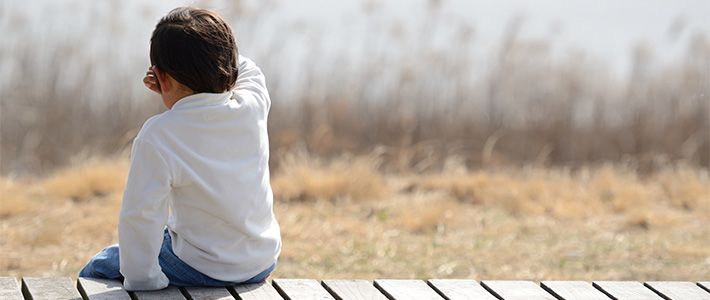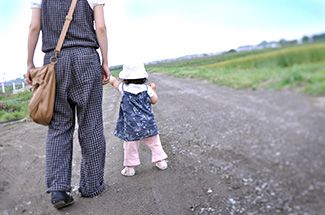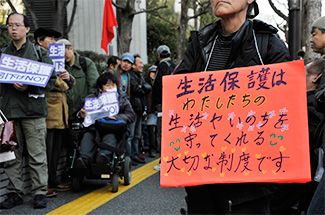
Child Poverty, the Grim Legacy of Denial
Society- English
- 日本語
- 简体字
- 繁體字
- Français
- Español
- العربية
- Русский
Foreign tourists visiting Japan see clean, safe city streets filled with neat, well-dressed people. They encounter almost none of the familiar signs of urban poverty, such as slums decorated with gang-related graffiti or homeless people begging in the streets. These outward appearances have helped maintain Japan’s international reputation for economic fairness and equality. It is an image the Japanese themselves cherished for many years. But we know now that it is a myth.
Of course, like many myths, this one has some basis in reality. Back in the 1970s, economic disparities in Japan were minimal, on a par with those found in the Scandinavian countries. But the income gap began to widen in the 1980s. By 2009, Japan’s Gini coefficient—a common measure of income inequality—was 0.336, the eighth highest among the 35 countries of the Organization for Economic Cooperation and Development. Although still ahead of countries like the United States and Britain in terms of economic equality, Japan has fallen behind much of continental Europe, including countries like Germany and France, not to mention Scandinavia.
Hidden Poverty in a Culture of Shame
Within Japan, the myth of economic equality began to crumble early in this century. But even when it became clear that income disparities were growing, the Japanese people were unable to accept the notion that their affluent society had its own poverty problem.
What we are talking about here is not “absolute poverty,” defined as severe deprivation with regard to such basic human needs as food, clothing, and shelter. Although this is still a major problem in developing countries, nations in the industrial and emerging world are more focused on the issue of “relative poverty.” In any given society, relative poverty is defined as a level of income below that required to maintain the minimum acceptable standard of living for that society.
Relative poverty is a serious problem even in the OECD countries with the highest per capita gross domestic product, and most governments treat it as such. Detailed poverty statistics and policy information are readily accessible on the government websites of most OECD countries. The European Union’s 10-year growth strategy Europe 2020 adopts the numerical target of “at least 20 million fewer people in or at risk of poverty and social exclusion” by the year 2020.
But Japan has only recently begun coming to grips with the issue. For many years even policy makers and academics continued to subscribe to the myth of economic equality. In the 1960s the government gave up keeping poverty statistics and calculating the nation’s poverty rate, making it difficult to gauge the severity of the problem. Although there was public livelihood assistance for low-income households, only about 1% of the population was receiving benefits, and almost all of those beneficiaries were either disabled persons or elderly citizens without pensions.
But underlying this low level of public assistance—and the failure to recognize the need for more—is the fact that poverty in Japan tends to be carefully hidden. In a society where equal economic opportunity is a given, poverty is seen as a personal failure. Moreover, the shame of seeking public assistance reflects on the entire extended family, making such a step extremely difficult, no matter how straitened one’s circumstances. This same sense of shame makes people conscientious about avoiding any outward appearance of want. They are at great pains to remain respectably attired, for example, even if it means borrowing money or skimping on meals. In the past, if one encountered homeless people in the subway, for example, one assumed they were alcoholics or misfits who had brought the situation on themselves, not victims of social inequality.
These attitudes began to change in 2008. In the economic recession triggered by the US subprime mortgage crisis, it became clear that a bad break could plunge almost anyone into poverty. People were shocked to learn that even in a country with putative universal health insurance, there were some 30,000 children with no coverage at all. When the Democratic Party of Japan came to power in 2009, ousting the long-ruling Liberal Democratic Party, one of the first things it did was publish relative poverty figures for Japan. These statistics placed the overall child poverty rate at 15.7% and the rate for single-parent households at 50.8%. (As of 2012, these figures had risen to 16.3% and 54.6%, respectively, according to the Ministry of Health, Welfare, and Labor.)
Children and the Cycle of Poverty
The DPJ instituted several new policies to address the problem, establishing a universal child allowance and tuition-free high school. In 2012, in the wake of the Great East Japan Earthquake, the LDP returned to power. But by then, various studies and media exposés had uncovered the grim truth about childhood poverty in Japan. The poor were everywhere, and the troubling repercussions of their situation could no longer be ignored.
In 2009, the Ministry of Education, Culture, Sports, Science, and Technology released a study that found a close correlation between Japanese children’s academic performance, as measured by the nationwide achievement test administered to sixth-graders, and their parents’ income. Of course, this relationship is well known in other countries, but in Japan, with its longstanding assumptions of equal opportunity and a classless society, even public officials and educators greeted this rather obvious finding with exclamations of shock and surprise.
My own 2010 paper detailing the correlation between children’s health and family income caused a comparable burst of consternation. Similarly, recent research has established that childhood obesity tends to be more prevalent among low-income families in Japan, as elsewhere. These and other studies published in recent years have forced the Japanese to acknowledge the fact that, even in their presumably classless society, the growing disparities in household income have profound repercussions for children.
Anecdotal evidence from professionals who work directly with children has shed further light on the impact of poverty. Pediatricians talk about parents who fail to follow through on their children’s treatment plan because of the high copay, or who request that their children not be taken to the hospital even when they fall ill at school. Teachers tell of surreptitiously passing hard candy or leftover cartons of milk to students who come to school without breakfast and are unable to focus on their morning lessons. There have been reports of children growing thin over the summer break, when they are unable to take advantage of school lunches. Thanks in large part to media coverage, people have finally come to the realization that child poverty is a serious social problem in Japan.
Too Little, Too Late
In 2013, in response to this growing awareness, the Diet unanimously passed the Childhood Poverty Act, which called for unspecified measures to combat the problem. In 2014, the cabinet took the next step by approving a set of Guidelines on Measures to Combat Childhood Poverty. In a sharp departure from attitudes to date, the guidelines made schools the primary platform for implementing anti-poverty measures. In 2015, the first major government-funded programs under the new initiative went into effect. The government of Prime Minister Abe Shinzō launched the Project for Promotion of Independence of Single-Parent Families and Families with Multiple Children. The fiscal 2016 draft budget approved on December 22 last year includes allocations to expand “scholarships” (interest-free education loans), raise the child-rearing allowance (a cash benefit for low-income single-parent households), and increase subsidies to households with more than one child.
But some would argue that these changes are little more than cosmetic improvements to a system that is fundamentally flawed. Where higher education is concerned, the Japanese government does not even provide scholarships in the usual sense of the term, only public loans (which it refers to as shōgakukin). The percentage of tertiary education costs borne by private households is among the highest in the OECD. As for the child-rearing allowance, the level of assistance the government offers single-parent families is nowhere near sufficient: a maximum of ¥42,000 per month for a parent with one child, plus ¥5,000 for the second child and ¥3,000 for any additional children. The poverty rate for single-parent households (almost all of which are single-mother households) is more than 50%, despite the fact that 80% of single mothers are employed. Less than 20% of divorced mothers are receiving child-support payments from the father, largely because there is no system in place to enforce payment.
The number of households receiving public assistance has grown in recent years, but it still amounts to only around 2% of the population. The universal child allowance is too small to be of much help. And Japan offers none of the housing and food subsidies that other countries have put in place to support low-income families. Meanwhile, regressively structured social insurance premiums (such as those for national health insurance) place a disproportionate burden on the poor.
Blinded to poverty by the myth of equality, Japan neglected to make adequate provision for the economically disadvantaged in its social systems and public policies. As a result, it lags far behind other advanced industrial democracies in addressing poverty in general and childhood poverty in particular. This is the ironic legacy of Japan’s brief golden age of economic equality.
(Originally written in Japanese on January 12, 2016, and published on January 22, 2016.)▼Further reading
 The Plight of Japan’s Single Mothers Akaishi Chieko The Plight of Japan’s Single Mothers Akaishi Chieko |  Wrestling with Poverty and Income Inequality Komamura Kōhei Wrestling with Poverty and Income Inequality Komamura Kōhei |
Abe Shinzō OECD education equality children poverty single mothers social welfare